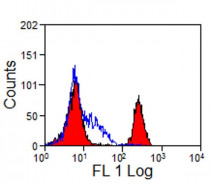ARG22650
anti-CD4a antibody [MIL17]
anti-CD4a antibody [MIL17] for Flow cytometry,IHC-Frozen sections and Pig
Developmental Biology antibody; Immune System antibody; Regulatory T cells Study antibody; T-cell infiltration Study antibody; Tumor-infiltrating Lymphocyte Study antibody
Overview
| Product Description | Mouse Monoclonal antibody [MIL17] recognizes CD4a This antibody recognizes a 55kDa Porcine homologue to the Human CD4 antigen found on the surface of helper-T cells. MIL-17 was confirmed as a member of the CD4 alpha cluster at the a Third International Workshop on Swine Leukocyte Differentiation Antigensa (Haverson et al. 2001). Porcine CD4 is a type 1 trans-membrane member of the immunoglobulin superfamily. Pigs appear unusual amongst mammalian species as they appear to have four populations of resting T lymphocytes. In addition to the two populations of mutually exclusive CD4+/CD8- and CD4-/CD8+ lymphocytes, they also appear to have significant populations of CD4-/CD8- and CD4+/CD8+ cells. Lymphoblasts with a double positive phenotype have been described in other species but this is not the case for mature T lymphocytic calls (Saalmuller et al. 1987)Mouse anti Pig CD4 alpha, clone MIL17 stains a population of cells with characteristic lymphocyte morphology in immunohistochemistry (Inman et al. 2010). |
|---|---|
| Tested Reactivity | Pig |
| Tested Application | FACS, IHC-Fr |
| Host | Mouse |
| Clonality | Monoclonal |
| Clone | MIL17 |
| Isotype | IgG2b |
| Target Name | CD4a |
| Antigen Species | Pig |
| Immunogen | Leucocytes isolated from porcine gut lamina propria. |
| Conjugation | Un-conjugated |
| Alternate Names | CD4mut; CD antigen CD4; T-cell surface glycoprotein CD4; T-cell surface antigen T4/Leu-3 |
Application Instructions
| Application Suggestion |
|
||||||
|---|---|---|---|---|---|---|---|
| Application Note | FACS: Use 10 µl of the suggested working dilution to label 10^6 cells in 100 µl * The dilutions indicate recommended starting dilutions and the optimal dilutions or concentrations should be determined by the scientist. |
Properties
| Form | Liquid |
|---|---|
| Purification | Purification with Protein A. |
| Buffer | PBS and 0.09% Sodium azide. |
| Preservative | 0.09% Sodium azide |
| Concentration | 1 mg/ml |
| Storage Instruction | For continuous use, store undiluted antibody at 2-8°C for up to a week. For long-term storage, aliquot and store at -20°C or below. Storage in frost free freezers is not recommended. Avoid repeated freeze/thaw cycles. Suggest spin the vial prior to opening. The antibody solution should be gently mixed before use. |
| Note | For laboratory research only, not for drug, diagnostic or other use. |
Bioinformation
| Gene Symbol | CD4 |
|---|---|
| Gene Full Name | CD4 molecule |
| Background | CD4 is a membrane glycoprotein of T lymphocytes that interacts with major histocompatibility complex class II antigenes and is also a receptor for the human immunodeficiency virus. This gene is expressed not only in T lymphocytes, but also in B cells, macrophages, and granulocytes. It is also expressed in specific regions of the brain. The protein functions to initiate or augment the early phase of T-cell activation, and may function as an important mediator of indirect neuronal damage in infectious and immune-mediated diseases of the central nervous system. Multiple alternatively spliced transcript variants encoding different isoforms have been identified in this gene. [provided by RefSeq, Aug 2010] |
| Function | CD4 is an integral membrane glycoprotein that plays an essential role in the immune response and serves multiple functions in responses against both external and internal offenses. In T-cells, functions primarily as a coreceptor for MHC class II molecule:peptide complex. The antigens presented by class II peptides are derived from extracellular proteins while class I peptides are derived from cytosolic proteins. Interacts simultaneously with the T-cell receptor (TCR) and the MHC class II presented by antigen presenting cells (APCs). In turn, recruits the Src kinase LCK to the vicinity of the TCR-CD3 complex. LCK then initiates different intracellular signaling pathways by phosphorylating various substrates ultimately leading to lymphokine production, motility, adhesion and activation of T-helper cells. In other cells such as macrophages or NK cells, plays a role in differentiation/activation, cytokine expression and cell migration in a TCR/LCK-independent pathway. Participates in the development of T-helper cells in the thymus and triggers the differentiation of monocytes into functional mature macrophages. [UniProt] |
| Highlight | Related products: CD4 antibodies; CD4 ELISA Kits; CD4 Duos / Panels; Anti-Mouse IgG secondary antibodies; Related news: New antibody panels and duos for Tumor immune microenvironment Tumor-Infiltrating Lymphocytes (TILs) |
| Research Area | Developmental Biology antibody; Immune System antibody; Regulatory T cells Study antibody; T-cell infiltration Study antibody; Tumor-infiltrating Lymphocyte Study antibody |
| Calculated MW | 51 kDa |
| PTM | Palmitoylation and association with LCK contribute to the enrichment of CD4 in lipid rafts. |
Images (1) Click the Picture to Zoom In






